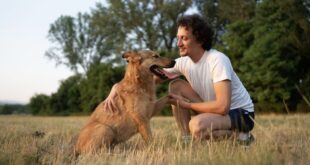
If you own multiple dogs, or let your dog socialise with other dogs, you’ll know they love to play with each other. This is a normal and healthy activity that strengthens social bonds, develops skills, and provides exercise and mental stimulation.
Dogs playing together have a variety of behaviours – such as chasing, wrestling, and nipping. They often show clear signals that distinguish it from aggression, such has them having a relaxed body language, taking turns chasing or wrestling, and taking pauses and breaks to let the other dog know they’re still just playing.
However, sometimes it can be difficult to notice when the playfights go a bit too far and become actual fights or disagreements between your dogs. It can happen suddenly – with their body language changing slightly.
To help people catch these changes, preventing play fights turning more serious, dog trainer Cherry Hoggs has shared some signs you should look out for.
“Would you know if your dog is playing or warning?” she asked at the beginning of her social media video.
“Knowing your dog is crucial during any activity but especially off leash and during playtime. This is to keep everyone safe!”
To help, she went on to share some subtle dog signs that you might miss.
“Here you can see our two bullies together engaging with each other in a play that could escalate,” she said as she showed a video of the two dogs in her garden.
“You’ll notice the tense wag of their tails, they look as though they’re having a stare off, but they’re actually avoiding eye contact, and almost sizing each other up.”
The moment then turned a bit more tense – without the dogs making a noise or moving from their spots.
Cherry explained: “Now here you see their tails completely stop wagging. Our brindle dog actually turns to walk away and then lays down, the ultimate sign of submission.”
However, her other two dogs then came in to break up the fight, with Cherry explaining: “However the key cue here that would often be missed is our two other pack members walk clearly between them to break the play and fixation. The pack is very intuitive and although we may not always pick up on subtle cues, they always do.”
To ensure playtime stays under control, it’s important to monitor your pets and keep an eye on their gestures for clues about how they’re feeling.
In the example Cherry showed, this was when the tails stopped wagging and the dogs began avoiding eye contact.
Taking to the caption of the video, Cherry explained: “Our opinion is any escalation can be prevented when knowing your dog and understanding, dog ‘language’. Obviously somethings can catch anyone off guard but if you think about those situations, did you have full concentration on your dog?”
In order to teach yourself your dog’s signs and body language, she said: “If your like us you’ve developed eyes on the back of your head so it’s pretty difficult for any escalation to get pass us. Plus we study our dog every day. Plus every evening we talk through the whole day and our dog’s behavior to analyse.”
People soon took to the comment section of Cherry’s video, with many praising the dog trainer for her informative video.
“This is amazing. Very informative,” one viewer wrote, as a second person shared: “Very cool. I really like these breakdowns on body language. Very helpful.”
Meaqnwhile, another user commented: ” That’s amazing! Those two dogs saying ‘leave it!’ As they cause a distraction.”
 Latest World Breaking News Online News Portal
Latest World Breaking News Online News Portal






